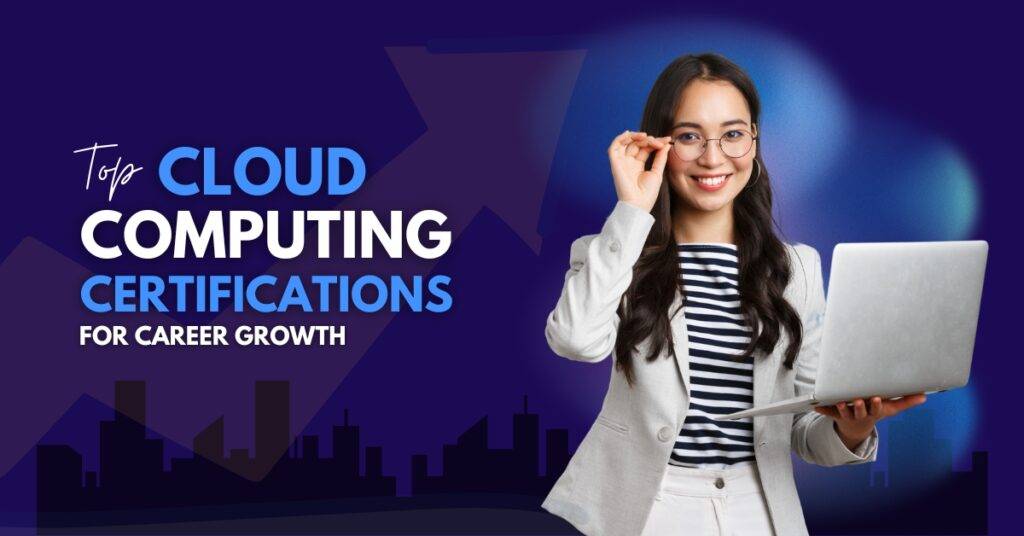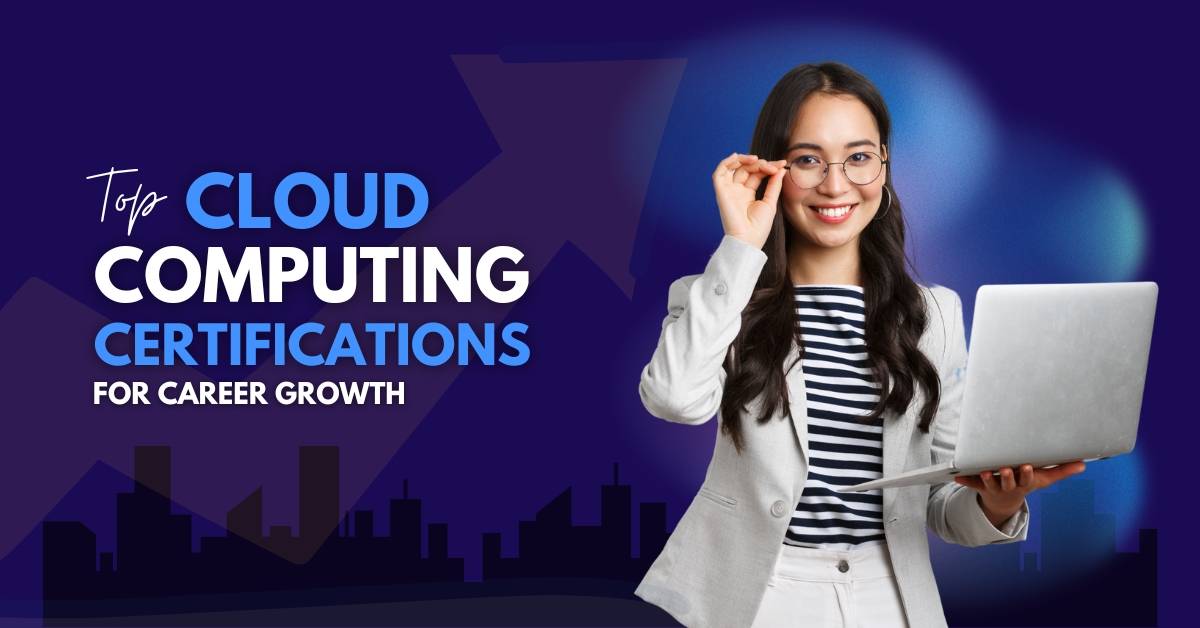
Introduction to Cloud Computing
In the rapidly evolving technological world, cloud computing is emerging as an innovation driving digital transformation in companies across all industries. In this guide, you will learn about cloud computing and discover the many opportunities it offers for career advancement. You can improve your knowledge by taking cloud computing courses, which provide key information about cloud computing-related training programs and certifications. The guide provides an overview of cloud computing and its impact on technology and guides you through the basics.
What is Cloud Computing?
The cloud enables businesses and individuals to access computing resources, including storage, servers, and databases, as well as network analytics, software, and intelligence, via the Internet (“the cloud”), allowing for faster development, a variety of resources, and cost savings. It is an essential topic for anyone who wishes to learn more about cloud computing. It lays the framework for seeing what cloud technology can do and its limitations.
“Embark on your Cloud computing career paths and certifications journey with Integrated IT Training today and unlock the door to endless opportunities in the IT world!”
Evolution of Cloud Computing
The study of the growth and development of cloud computing has become essential to anyone taking the cloud computing program. In this journey, we will discover how cloud computing evolved from simple virtualization methods to applications and now to large infrastructures that provide a variety of services.
Importance and Benefits of Cloud Computing
Cloud computing certification programs recognize the value and advantages of cloud computing. Cloud computing offers companies the ability to scale up, to be more efficient, more flexible, and to collaborate more effectively.
Understanding the Fundamentals
The foundations of cloud computing make up the basis of every training program, giving learners the skills to utilize the ecosystem efficiently.
Cloud Service Models
- Infrastructure as a Service (IaaS)
IaaS provides cloud-based computing services that are virtualized over the internet. This is an essential cloud computing service model. Classes, which highlight the transition from hardware-based computing to cloud-based solutions.
- Platform as a Service (PaaS)
PaaS is a cloud-based platform that allows customers to build and launch applications and handle them without the hassle of creating and managing the infrastructure normally involved in developing and launching applications. This is a crucial feature when you want to get deeply into developing applications in the cloud.
- Software as a Service (SaaS)
SaaS provides software on the web every month. It’s the most recognizable type of cloud service to numerous users. It is also an essential element of cloud computing education, focusing on the model of software-on-demand.
Deployment Models
- Public Cloud
Clouds that are publicly managed and owned by third-party cloud service providers. They provide computing services like servers and storage via the Internet. This is the primary aspect of cloud computing certification programs. Showing the advantages and flexibility of cloud-based services offered by public clouds.
- Private Cloud
Private cloud refers to the computing resources one company or company utilizes. The private cloud could be located physically inside the on-site data center. Cloud computing courses typically examine private clouds in the context of improved security and management.
- Hybrid Cloud
Hybrid clouds connect private and public clouds through technology, allowing shared data and programs. This is a crucial aspect of cloud computing training course that offer flexibility and additional deployment options.
- Community Cloud
A community-based cloud is a cooperative effort that shares infrastructure across multiple organizations belonging to a certain group of people with similar concerns. Although this model is not the norm, it is a subject of advanced cloud computing classes due to its unique method of providing collaborative cloud computing.
Exploring Cloud Computing Technologies
- Virtualization
Virtualization is an essential technology used in cloud computing. It lets multiple virtual environments, or dedicated resources, be developed by a single physical system. This is a major topic of cloud computing courses, which allows efficient use of resources for computing, cutting costs and increasing flexibility.
- Containers
Containers provide a light, portable, and self-sufficient platform for running programs. Developers can package the application and its dependencies in a single image that can be run continuously across all computing environments. This is essential for courses in cloud computing that concentrate on application deployment, modernization, and administration.
- Microservices
Microservices architecture cuts applications into their most basic parts, which run independently. This allows for greater scalability and control over app development and deployment, often covered in the most advanced cloud computing training workshops, to understand its effects on agility and continuous delivery.
- Server less Computing
Server less computing is an execution model in which the cloud provider can dynamically handle the distribution and provisioning of servers. The server less model lets developers create and manage applications and services without worrying about the infrastructure behind it, which is a key concept in cloud computing classes emphasizing scaling and cost efficiency.
Cloud Computing Architecture
- Components of Cloud Architecture
Cloud architecture refers to diverse components of database capabilities, software apps, and so on, which enable utilizing cloud computing resources to address business issues. Understanding these components is vital when preparing cloud computing-related training programs to create successful cloud solutions.
- Design Principles
The cloud computing design guidelines provide best practices and techniques for creating scalable, stable Cloud infrastructure certification that are efficient and reliable. These rules guide the design choices in cloud computing certification programs that focus on optimizing cloud computing deployments.
- Scalability and Elasticity
The ability to scale and elasticity are the primary aspects of cloud computing. They are making it possible for systems to handle increasing volumes of work effectively or expand easily. Cloud computing classes often highlight the concepts of elasticity and scale to demonstrate how cloud resources can be continuously adjusted to keep up with ever-changing demands.
Cloud Computing Infrastructure
- Data Centers
Data centers form the foundation of cloud computing. They house the actual servers and network equipment that provides cloud-based services. Understanding the design, architecture, and management of data centers is essential for anyone who wants to become a cloud engineer.
- Networking in the Cloud
The cloud network is the interconnection of cloud services and resources. These include connected networks that are virtual and dedicated, as well as the internet, which ensures the security and efficiency of data transmission through cloud services. It is a major area of interest in cloud computing courses.
- Storage Solutions
Cloud storage solutions offer scalable and dependable data storage over the internet. Cloud computing training encompasses a range of storage options, such as object storage, file storage, and block storage. All of them are suitable for different types of data and usage scenarios.
Security in the Cloud
- Challenges and Concerns
Security Cloud addresses particular challenges and worries in protecting information, applications, and cloud-based infrastructures, which include data breach problems with compliance and security vulnerabilities to cyberattacks.
- Best Practices for Securing Cloud Environments
Protecting your cloud environment starts with implementing comprehensive security practices like identity management, encryption, vulnerability scanning, and incident response plans. It includes implementing robust security controls for access, encryption, and security measures for networks and regular security tests, which are important aspects of cloud computing classes.
- Compliance and Regulatory Considerations
Knowing compliance and regulations requirements is crucial to ensure that cloud computing services conform to the legal and regulatory standards. Cloud computing courses typically cover important regulations and standards that affect cloud computing, including GDPR, HIPAA, and PCI-DSS.
Emerging Trends in Cloud Computing
- Edge Computing
Edge computing expands cloud computing by moving the data and computation closer to which it is required for faster response and to conserve bandwidth. The trend is becoming more crucial in cloud computing classes due to its significance in IoT and real-time analytics.
- Multi-Cloud Strategies
Multi-cloud plans involve using the solutions from multiple cloud providers to not depend on a single cloud provider, improve resilience, and make the most of what each can provide. Today’s training in cloud computing usually includes planning strategies for deployments that use multiple cloud providers.
- Artificial Intelligence and Machine Learning in the Cloud
The combination of AI and machine learning within the cloud can provide the most powerful capabilities in analytics and intelligence, which drive innovations across different sectors. Cloud computing certification programs include AI and machine learning subjects and their increasing importance to cloud ecosystems.
How Integrated IT Training Powers Your Cloud Computing Career
Integrated IT Training, an e-learning platform dedicated to IT training, is at the top of this education revolution, specifically in cloud computing. Its curriculum is specifically designed for novices and experienced professionals; Integrated IT Training offers an extensive set of classes and accreditations designed to equip users with the skills and abilities required to succeed on the cloud in computing.
Tailored Learning Pathways
Integrated IT Training takes into account the varied backgrounds and interests of students. If you’re seeking to begin a job in the field of cloud computing, hoping to improve your knowledge and obtain special certifications, the platform we offer is tailored education routes. They include an introduction to cloud computing. It also includes deeper explorations of technologies such as microservices, containers, virtualization, serverless computing, and advanced subjects in cloud architecture and security.
Comprehensive Cloud Computing Curriculum
Our course covers all aspects of cloud computing according to our guidelines. Beginning with the fundamentals of cloud computing and its development and advancements in technology and architectural concepts, Integrated IT training ensures that you are armed with a solid base and a deep understanding of:
- Cloud Service Models Find out the basics of IaaS, PaaS, and SaaS and how these models could be leveraged to improve the business’s innovation and efficiency.
- Deployment Models Get insights into private, public, hybrid, and community clouds by understanding their distinctive advantages and applications.
- Cloud Computing Technologies: Master virtualization containers, microservices, and serverless computing. This will equip you with the knowledge to develop and build contemporary applications.
- Cloud Computing Architecture and Infrastructure: Know the key components of cloud architecture and design concepts, such as data centers, networking storage, and other solutions for creating the foundation for a robust cloud infrastructure.
- Security on Cloud Security Cloud: Learn about the intricacies of cloud security. Learn about best practices, conformity, and regulatory issues to ensure the security of cloud-based environments.
Conclusion
Integrated IT Training is much more than just an e-learning tool; it is a companion in the development of your career within the field of cloud computing through providing extensive training, real-world experience, and unwavering help. We aim to equip individuals with the knowledge and skills required to succeed in cloud computing. Sign up for Integrated IT Training today and begin the journey to becoming an expert in cloud computing, prepared to face the opportunities and challenges of the digital age.
What is the difference between cloud computing and traditional computing?
Unlike traditional computing, cloud computing relies on internet-based services to deliver computing resources, which depend on local servers or personal devices.
How do I choose the right cloud computing career path?
Consider where your passions align with market demands, evaluate your interests and skills, and research the various roles within cloud computing.
What skills are most in demand for cloud professionals?
Skills in cloud service platforms (AWS, Azure, GCP), automation, DevOps, containerization, and cybersecurity are highly sought after.
Can I transition to a cloud career from a non-technical background?
Cloud careers can be achieved with dedicated training and learning in IT and cloud computing.
What are the biggest challenges facing cloud computing professionals today?
Keeping up with rapid technological changes, managing multi-cloud environments, and ensuring data security and compliance are significant challenges.
How can I stay updated with the latest trends in cloud computing?
Follow industry news, participate in online forums and webinars, and engage with professional networks and continuous learning platforms.







Leave a Reply